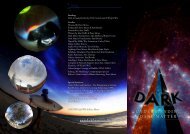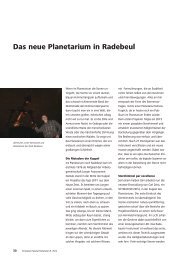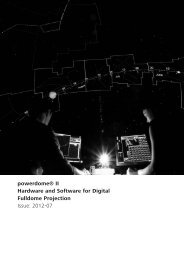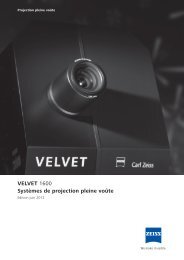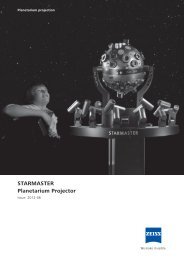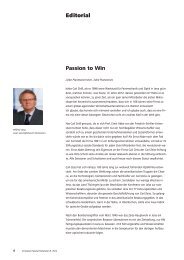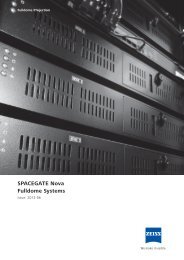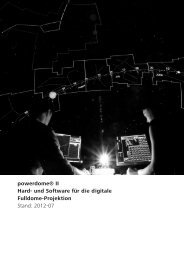Innovation Special Planetariums 9 - Carl Zeiss Planetariums
Innovation Special Planetariums 9 - Carl Zeiss Planetariums
Innovation Special Planetariums 9 - Carl Zeiss Planetariums
Create successful ePaper yourself
Turn your PDF publications into a flip-book with our unique Google optimized e-Paper software.
A Day of “Space Experiences”<br />
at the Planetarium Am Insulaner<br />
Friday, 09:45 a.m.: When he sees a<br />
shooting star, Tim makes the wish to be<br />
able to fly to the moon. His big brother<br />
just laughs at him – suddenly the sky<br />
starts turning at a dizzying speed, and<br />
then a glaring white light appears high<br />
above them. The light comes closer,<br />
enveloping the entire sky – and suddenly,<br />
the Earth, complete with all its<br />
continents and veiled by clouds appears<br />
above their heads. A large metal structure<br />
approaches at terrific speed – its<br />
upper portion gets bigger and bigger,<br />
already filling in half the dome... Stifled<br />
cries are heard from the auditorium,<br />
increasing in volume, as the walls of the<br />
metal structure disappear and the children<br />
suddenly find themselves among<br />
the blinking consoles and large viewing<br />
windows of a space station.<br />
Iskender, 7, a student at a Berlin school,<br />
slightly loosens his grip on the armrests<br />
of his seat, to which he had been holding<br />
on ever so tight. Next to him, Leonie<br />
finally breathes out. Their teacher, who<br />
had been following the entire process<br />
from two seats further away, smiles a<br />
little at the children’s excited whispering<br />
around her as they point out the<br />
details of the moving image on the walls<br />
of the dome to one another. But even<br />
she flinches when, 10 minutes later, the<br />
ice and rock fragments of Saturn’s rings<br />
noisily hit the windows of the space<br />
station. And when, finally, the space<br />
station is almost sucked into the sun<br />
34 <strong>Innovation</strong> <strong>Special</strong> <strong>Planetariums</strong> 9, 2012<br />
Dr. Monika Staesche, Scientific Director,<br />
Planetarium of the Wilhelm Foerster<br />
Observatory, Berlin.<br />
due to a computer malfunction, and<br />
the entire dome shakes violently above<br />
them, she too tightens her grip on to<br />
her armrests. “The ABC of the Stars”,<br />
the children are learning is a lot of fun,<br />
quite unlike a classroom lesson and<br />
much more like what Erich Kästner, the<br />
author of “Emil and the Detectives” and<br />
of the story that was made into the film<br />
“The Parent Trap” had once described in<br />
his “Flying Classroom”: “The world will<br />
be our classroom“. There is thundering<br />
applause at the end of the show, and<br />
then the children rush out of the dome,<br />
out into the real sunlight and on to the<br />
observatory on the hill.<br />
The next groups of students are already<br />
waiting, for the show will go on at<br />
11:00 a.m. The older children want<br />
to know more about the “Spaceship<br />
Earth”, for example, why there is day<br />
and night and how the seasons come<br />
about. This is a live presentation; the<br />
presenter first uses the traditional planetarium<br />
instrument at the center of the<br />
room in order to show and explain the<br />
view from the Earth, and then, with a<br />
quick click of the mouse, switches to<br />
the perspective from the outside. Suddenly,<br />
a gigantic, slowly and majestically<br />
turning Earth hangs from the dome over<br />
the children’s heads. There is a “Wow!”<br />
from the ranks. “It looks really real!“<br />
And that is certainly right. You could<br />
swear that there is no dome wall, but<br />
that it all “continues” beyond it: The<br />
Earth floats in the “space” of the dome.<br />
The borderline between day and night is<br />
clearly visible – and when the presenter<br />
adds the projection of the Earth’s axis, it<br />
becomes clear how “askew“ the Earth’s<br />
position actually is, and that people living<br />
near the South Pole do not get any<br />
sunlight at all, so that there it’s “night<br />
time” all day long.<br />
But that is not all. With a few mouse<br />
clicks, the scenery begins to change. For<br />
a moment, the stars turn at lightning<br />
speed, the Earth disappears into the<br />
distance, and a red dot appears, which<br />
quickly increases in size to reveal itself as<br />
the planet Mars. Details become apparent,<br />
including two tiny dots that circle<br />
around the planet – the two moons of<br />
Mars. In the end, the children are so<br />
close to Mars that it fills out the entire<br />
dome. No matter how beautiful it looks,<br />
the children learn that Mars is not a very<br />
hospitable environment for humans.<br />
Nor would any of the other planets of<br />
the solar system be a “second home” to<br />
move to if the Earth should ever become<br />
uninhabitable… In fact, humans liter-




